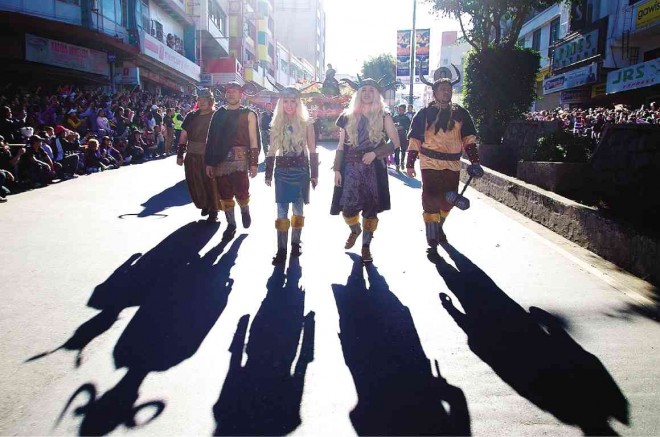
DRAGONS and Vikings surprised the Sunday crowd that turned up to see the 20th Baguio Flower Festival Grand Float Parade. The characters take off from a popular Hollywood animated movie. RICHARD BALONGLONG/INQUIRER NORTHERN LUZON
BAGUIO CITY—Had lawyer Damaso Bangaoet Jr., the founder of the Baguio Flower Festival, or Panagbenga, lived long enough to see his creation stage its 20th year anniversary, he would have been proven correct.
Before he died last September, Bangaoet said the festival’s mission to revitalize the city had been accomplished.
Like a well-oiled machine, residents of the summer capital woke up early on Saturday and on Sunday to set in motion this year’s staging of the festival parades.
At 6 a.m. on Feb. 28, work crews cleaned the streets as parents brought their children to downtown Baguio to give them time to dress up and rehearse their routines.
When the sun warmed up the streets at 8 a.m., so did the brightly garbed young performers who were cheered on by the crowd that lined Session Road.
The familiar Panagbenga hymn played loudly as 19 sets of street dancers took over the central business district for most of Saturday morning.
A much bigger Sunday crowd took in the grandeur of 16 participating floats.
Many of them were tourists who returned for a taste of the parades’ creativity, gauging by the increase in vehicular traffic in the city, although northbound traffic over the weekend along the Manila North Road from Urdaneta City to Sison town in Pangasinan province was light to moderate, said Senior Insp. Rommel Centeno, Sison police chief.
Supt. Jeff Fanged, Urdaneta City police chief, said the volume of vehicles exiting from the Tarlac-Pangasinan-La Union Expressway had been normal since Friday.
The festival ran smoothly because an experience of 20 years had fused the community, at least on the surface. “This has grown [by] magnitudes to what it is today because of cooperation. This is your festival, my festival, our festival,” Mayor Mauricio Domogan said in a speech.
But like the early festivals, this year’s event was also characterized by a tug-of-war for control between some city government officials and the business community operating Panagbenga.
The best example of this enmity was the 2006 staging of Panagbenga when then Mayor Braulio Yaranon held a separate festival under the Baguio Flower Festival Foundation Inc. (BFFFI).
Months before the 2015 festival, the BFFFI and members of the city council bickered over the festival’s revenue. In February, the BFFFI was shocked when the city government expanded a festival bazaar called Market Encounter to accommodate traders who were not screened for the project.
Before he died, Bangaoet said he regretted the absence of harmony among the people who put up the festival year after year, and was working out plans to remove anymore reason for the mistrust.
The festival started in 1995 as a Camp John Hay project to drum up interest in a city that had just been restored following the devastating 1990 Luzon earthquake.
The Bases Conversion and Development Authority put up Camp John Hay for lease to developers during that period, said Bangaoet, who pitched the idea of a tourist-drawing flower festival, based on suggestions made by friends. Bangaoet was then managing director of Camp John Hay.
Local businessmen made similar attempts, such as staging a salad festival, which succeeded for a time.
“When we were planning [a long-term tourist spectacle for Baguio], there were suggestions [to put up] a cañao (ritual feast) festival. But I was not too keen about the suggestion,” Bangaoet recalled.
He said the city used to stage a grand cañao until it drew criticisms for bastardizing the Cordillera culture.
Bangaoet said he was also sensitive to the impact of the ritual slaughter of pigs on the growing animal rights movement and the Catholic Church.
It did not take long for the community to take part in the festival’s evolution into a family-oriented affair.
Its sunflower motif was developed by high school student Trisha Tabangin. The Panagbenga hymn was composed by the late Macario Fronda, a Saint Louis University professor.
The festival organizers decided to make February the festival month.
“February was not a busy month for visitors. It was a lean month for business … . Why schedule it in December when people come up for the cold weather? Why put it on Holy Week when people come here anyway?” Bangaoet said.
Volunteerism was key to the festival’s early successes, Bangaoet said, citing the contribution of local flower traders and landscapers, the city’s schools, and the “Pony Boys” of Baguio, who performed tricks on horseback during many of the events.
The early festivals were also fun, said Michelle Jon Boragay, who performed for the Baguio Central School (BCS) drum and lyre band at the first Panagbenga parade when she was in Grade 2.
“My primary reason for joining the first parade was the costume,” said Boragay, now a nurse working in Saudi Arabia.
Much like in the Saturday parade, Boragay said, her mother tagged along when she performed for the first time, carrying a towel, a water container and snacks, while her father stayed in the crowd to take photographs.
Boragay was coached by Perlita Abiang, 75, who served as BCS’ band coordinator.
Abiang, who taught Grade 1 pupils at that time, said the children joined for the love of performing—a passion, Bangaoet said, that should be restored in future festivals.
“We have started feuding over how much we earn and who keeps the money, how much the government is willing to subsidize or how much we need to spend. The first years were always the best because we all did this for free—to show the world this is what being in Baguio was all about,” Bangaoet told the Inquirer. Reports from Vincent Cabreza, Desiree Caluza, Jhoanna Marie Buenaobra and Gabriel Cardinoza, Inquirer Northern Luzon